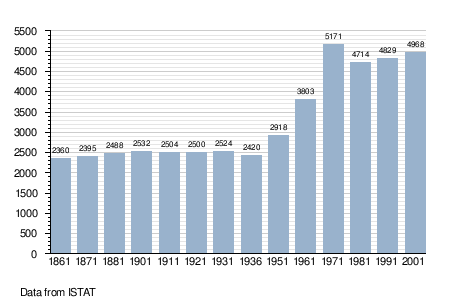Viggiù
| Viggiù | |
|---|---|
| Comune | |
| Comune di Viggiù | |
.svg.png) | |
 Viggiù Location of Viggiù in Italy | |
| Coordinates: 45°52′N 8°54′E / 45.867°N 8.900°ECoordinates: 45°52′N 8°54′E / 45.867°N 8.900°E | |
| Country | Italy |
| Region | Lombardy |
| Province / Metropolitan city | Province of Varese (VA) |
| Frazioni | Baraggia |
| Government | |
| • Mayor | Antonio Mario Giovanni Banfi |
| Area | |
| • Total | 9.3 km2 (3.6 sq mi) |
| Elevation | 506 m (1,660 ft) |
| Population (Dec. 2004) | |
| • Total | 5,148 |
| • Density | 550/km2 (1,400/sq mi) |
| Demonym(s) | Viggiutesi |
| Time zone | CET (UTC+1) |
| • Summer (DST) | CEST (UTC+2) |
| Postal code | 21059 |
| Dialing code | 0332 |
| Website | Official website |
Viggiù (Vigiǘ in Milanese) is a comune (municipality) in the Province of Varese in the Italian region Lombardy, located about 50 kilometres (31 mi) northwest of Milan and about 8 kilometres (5 mi) northeast of Varese, on the border with Switzerland. As of 31 December 2004, it had a population of 5,148 and an area of 9.3 square kilometres (3.6 sq mi).[1]
The municipality of Viggiù contains the frazione (subdivision) Baraggia.
Viggiù borders the following municipalities: Arcisate, Besano, Bisuschio, Cantello, Clivio, Meride (Switzerland), Saltrio.
Demographic evolution

Monuments and places of interest
Viggiù is recognizable for the largerly open courtyards; originally factories, where the stone was cut and shaped. Viggiù is also called "the land of picasass" (the land of stonecutter) as during the old times walking among its streets, you could hear the ringing of hammers cutting marble stones.
Many churches are enriched by the works of local artists. In the heart of the town lies Villa Borromeo (municipal property), an elegant late-neoclassical building, adorned with a nice green area, making it ideal for daily excursions of viggiutesi. The villa, with a C plan is an open courtyard facing Via Roma. It is delimited by a light colonnade, in the central part, forming a sort of semicircle to facilitate the view. The part of the building facing the park has a very linear design, the main entrance is decorated with an austere portico supported by heavy Tuscan columns. The stable (now the Museum of Picasass) which rises in the park has a circular form and its walls are decorated with horse heads in terracotta over this building. The ancient orangery, which since 2007 has been housing the Museum of nineteenth century Viggiutese Sculpture, is featuring works by: Angelo Bottinelli, Antonio Bottinelli, Luigi Buzzi Leone, Giuseppe Buzzi Leone, Antonio Argenti, and Giosuè Argenti. The villa is currently used for art exhibitions organized during summer.
The complex of the Enrico Butti Museum consists of several collections of works by famous viggiutese sculptors such as Enrico Butti, Giacomo Buzzi Reschini, Nando Conti, Luigi Bottinelli, Vincenzo Cattò, Gottardo Freschetti and Ettore Cedraschi.
Finally the Vidisello Cascina, located atop a small hill, is characterized by cultivated terraces. It seems that this structure has arisen on the ruins of an ancient Roman camp and is surveyed in the cadastre of Maria Theresa of Austria. Owned by the Buzzi family, the current structure has a "U" type structure with an inner courtyard, where arcades and galleries dominate: a testimony of its specific connection with farming activities. Beautiful frescoes decorate the walls of the courtyard below.
St. Stephen Parish Church
The original building, in Romanesque style, was erected at the limit of a crown of houses, which constituted a large and high amphitheater facing the Valceresio area. The church was enlarged in the fifteenth century to reach its current size, three wide aisles, divided into four bays, separated by six columns at the ends of Saltrio monolithic stone and surmounted by capitals.
Notable residents
- Gianni Danzi (1940–2007), Roman Catholic Archbishop of the Territorial Prelature of Loreto
- Sandy Cane, (1961 - ), the first black mayor of Italy elected in June 2009.